Elections happen all over the world at different times of the year, so it seems like there’s a never-ending parade of polls being reported on the news. While votes are cast privately, polls are used to take the temperature of the public, gauge the success of campaign strategies, and predict the outcomes of elections. But the word “poll” describes more than just the political voting process. It encompasses everything from an Instagram poll where users ask their followers to vote in answer to a question, like this one on lipstick colors by Sephora, to the unforgettable Heathers lunchtime poll.
Take a Headcount
The word “poll” originated far away from politics. As early as the 12th century, “Polle” was a surname, but in 1300, the common noun was used to describe the “hair of the head; piece of fur from the head of an animal.” It later developed to refer to the whole body, and from there the connection to its voting meaning becomes clearer. In the 1600s, still used as a noun, a “poll” was a “collection or counting of votes.” The first recording of a “poll tax,” literally a “head tax,” is from the 1690s.
In the mid-19th century, “poll” was defined more clearly as “voting at an election,” and by the early 20th century, a broader meaning of “survey of public opinion” was in use.
Predicting Winners
George Gallup founded one of the most well-known polling organizations in Washington, D.C., in 1935. Gallup is known for being the first polling firm to accurately predict the results of Franklin D. Roosevelt’s victory in the 1936 presidential election.
Gallup’s influence on the industry was so significant, in fact, that he featured on the cover of Time magazine in May 1948.
At the time, as is the case today, polls weren’t limited to the political realm. These early pollsters inspired history professor Peter A. Shulman to set up a useful (and often humorous) Twitter account, Historical Opinion (@HistOpinion), which displays graphs and charts of the results from various opinion polls over the decades. These cover everything from political views to opinions on pasta — for example, 41% of people surveyed in 1997 believed that spaghetti best described their personality. Another poll from July 12, 1937, asked respondents to name the most interesting book they had ever read. Of the 45% that could name an interesting book, the top two replies were the Bible and Gone With the Wind. Other responses (with drastically fewer poll responses) included David Copperfield, Ben Hur, Les Misérables, and Anthony Adverse.
Many of these historical polls are not quite as lighthearted — Shulman also posts poll results from 100 years ago on topics related to modern issues, to contrast how opinions and voter sentiment on hot-button issues have (or have not) changed over the decades.
Getting It Right
Polls are not always accurate, as most dedicated pollsters warn. One historical blunder took place during the 1996 Arizona primary, when opinion polling showed Pat Buchanan would be the winner, and he actually landed in last place. The error was due in large part to his own supporters actively seeking out pollsters to promote the idea of Buchanan winning. Thanks to these efforts, Buchanan supporters were overrepresented and skewed the results.
This highlights perhaps the greatest division between the archaic “poll” as a head of hair and the current “poll” as a survey. In the beginning, the word was used to describe a count of every single head (person), but now a poll is a representative sampling. The idea is that surveys can decipher the views of the public at large by focusing on a smaller, more manageable representative section of society.
Opinion polls can provide a fascinating, if generalized, window into public sentiment during a historical era. They offer insight into how people felt about or viewed contentious topics, even if they might not show us the whole picture. In this way, polls also help chart how public opinion shifts and changes over time, and how those views might differ depending on age, race, class, gender, and other marked characteristics.
Featured image credit: adamkaz/ iStock

